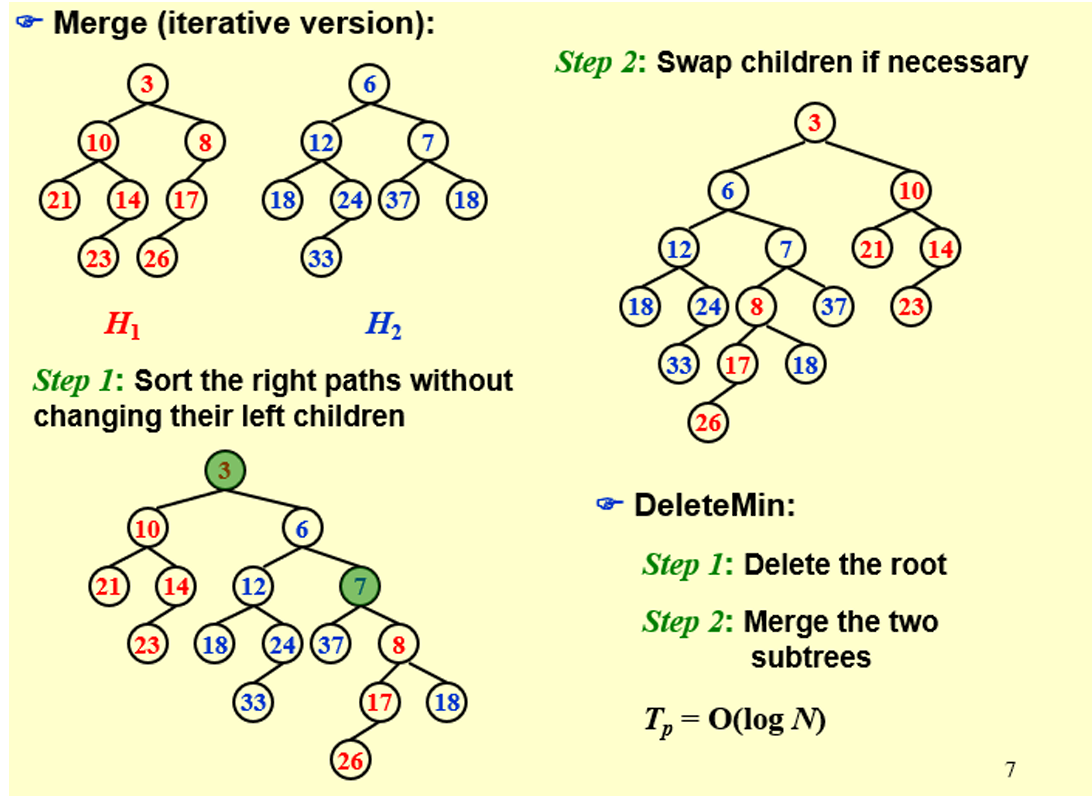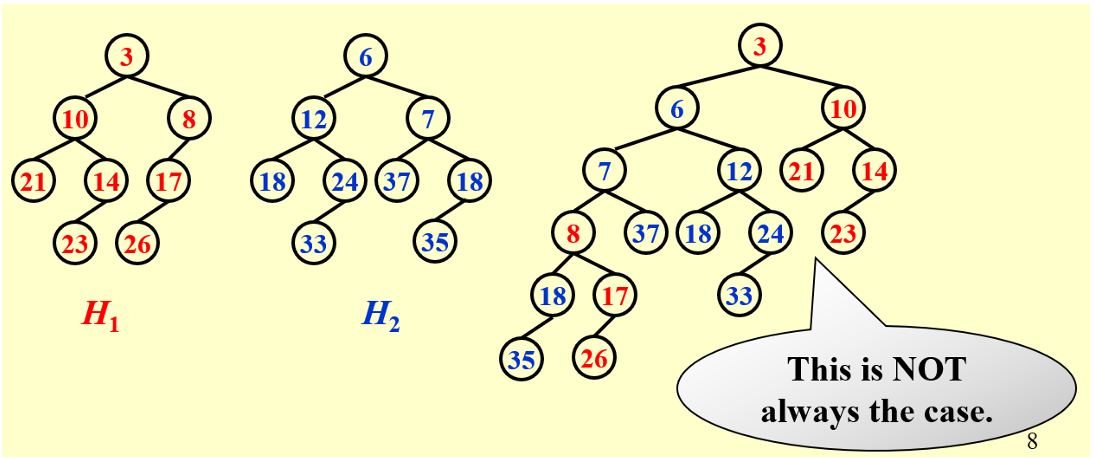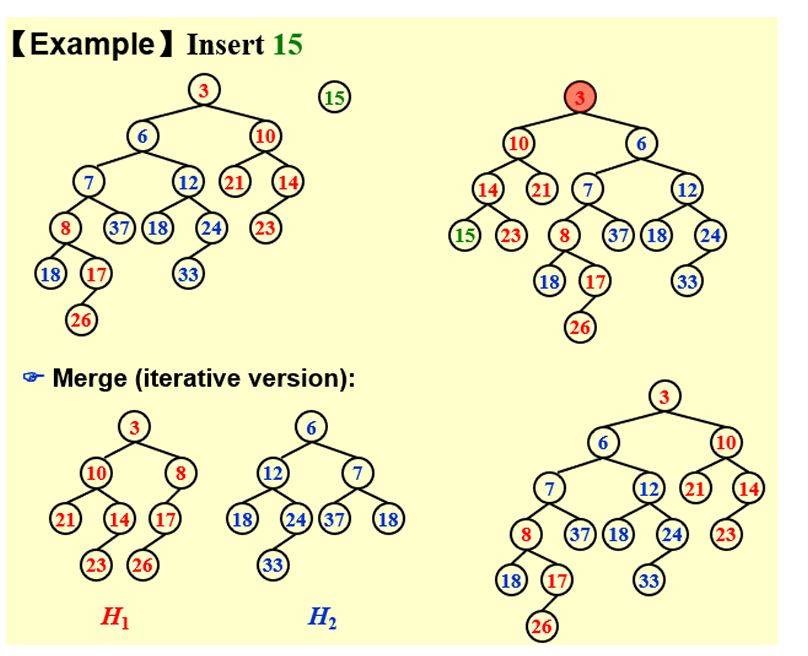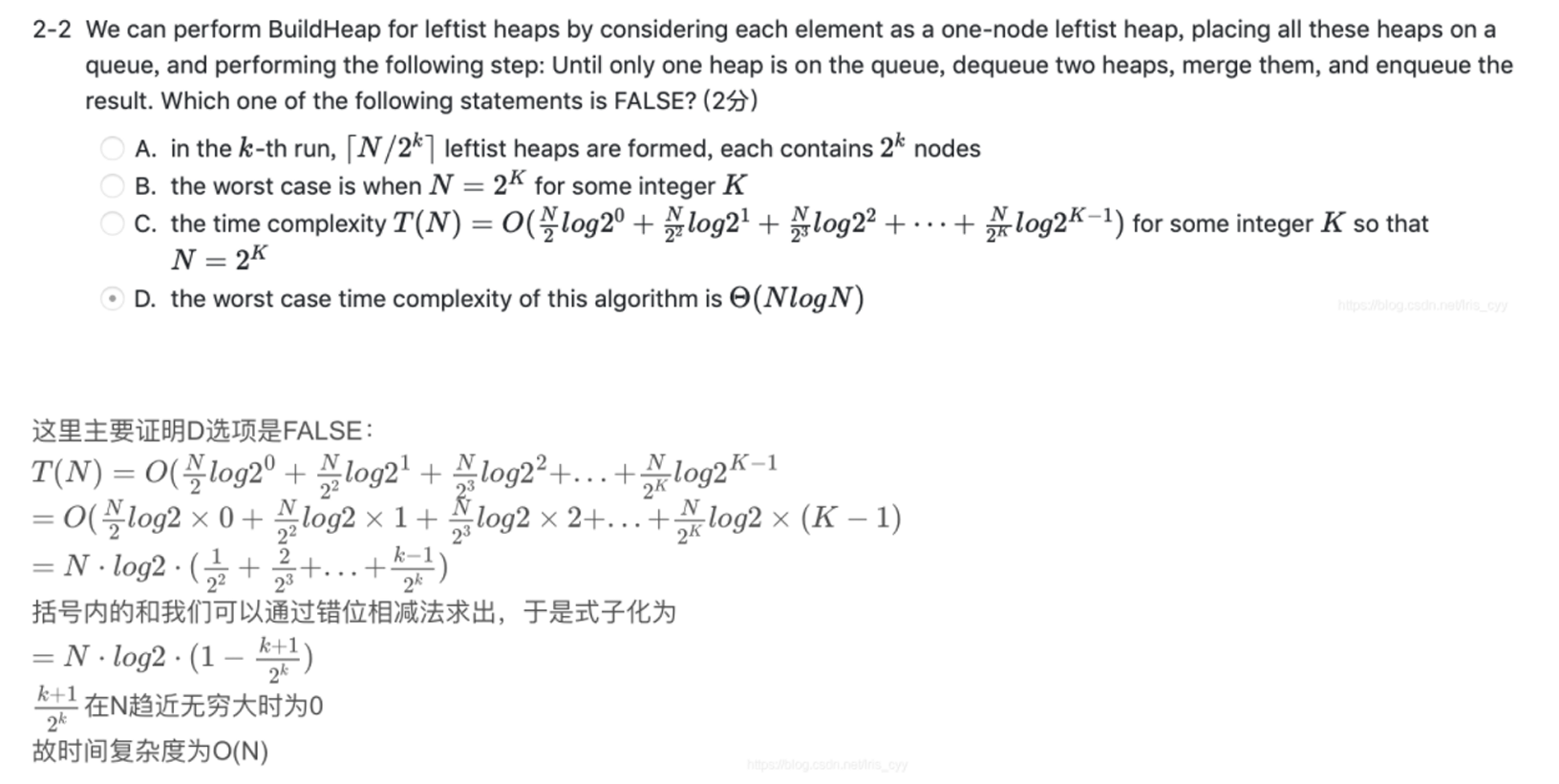合并方法:
- 先将\(H_2\)合并到\(H_1\)的右子树中,记录每一步被当作根的节点
- 从最后一个被当作根的节点开始,向上回溯
- 如果是左偏堆,则根据NPL判断是否需要交换左右子树
- 如果是斜堆,则始终交换左右子树
左偏堆 Leftist Heap
一、基础概念
Full Binary Tree:每个节点都有0/2个儿子
Complete Binary Tree:除了最后一层,每一层都满了
堆Heap:
- 任意一条从根到叶节点的路径,是有序的
- 结构性质、顺序性质
- 在O(n)的时间内,可以将两个堆合并
二、性质
空路径长度null path
length:Npl(X):
- 从节点x开始到叶节点的最短的路径长度
- Npl(x) = min{Npl(c) c为x的子节点} + 1
左偏堆Leftist Heap:
- 满足顺序性质,但是不满足结构性质(左子树size>右子树size)
- 对于左偏堆中的每个节点x,左子节点的空路径长度>=右子节点
节点上的数字,表示当前节点的Npl值

定理:如果左偏堆的右路径有r个节点,那么其至少有\(2^r\) - 1个节点 \[
\begin{aligned}
证明:&1.当r=1时,显然成立 \\
&2.当r>1时,假设k=r-1时,假设成立\\
&设当前节点为a,左子节点为b,右子节点为c\\
&对于此时的根节点,因为右路径为r,因此其NPL(c)\geq r-1\\
&由于左偏堆的性质,此时左子树满足NPL(b)\geq r-1\\
&由假设得,左右子树的节点个数均\geq 2^{r-1}-1 \\
&因此该子树的节点个数\geq 2^r-1
\end{aligned}
\]
三、结构体
struct LHeap{
int element;
LHeap* Left;
LHeap* Right;
int NPL;
};
|
四、合并
LHeap* Merge(LHeap* H1, LHeap*H2){
if(H1 == NULL) return H2;
if(H2 == NULL) return H1;
if(H1->element < H2->element) return Merge1(H1,H2);
else return Merge1(H2,H1);
}
LHeap* Merge1(LHeap* H1, LHeap* H2 ){
if (H1->Left == NULL){
H1->Left = H2;
}else {
H1->Right = Merge(H1->Right,H2);
if (H1->Left->Npl < H1->Right->Npl)
SwapChildren(H1);
H1->Npl = H1->Right->Npl + 1;
}
return H1;
}
|

斜堆 Skew Heap
一、合并
1.1 原理
总是交换左右子树,除非右面路径上的最大节点的子树没有被交换
任意M次连续操作,时间最多为O(M log
N),N=N1+N2


1.2 代码
struct Node {
int data;
Node* lch, * rch;
Node() {};
Node(int x) {
data = x;
lch = rch = NULL;
}
};
Node* root;
void SwapChildren(Node* H) {
Node* temp = H->lch;
H->lch = H->rch;
H->rch = temp;
}
Node* Merge(Node* H1, Node* H2) {
if (H1 == NULL)return H2;
if (H2 == NULL)return H1;
if (H1->data > H2->data) {
Node* temp = H1;
H1 = H2;
H2 = temp;
}
if (H1->lch == NULL)
H1->lch = H2;
else {
H1->rch = Merge(H1->rch, H2);
SwapChildren(H1);
}
}
|
二、时间复杂度证明
\[
\begin{aligned}
定义:&如果节点p的右子树的后代至少为p的后代数的一半,则p为重节点\\
&注意,p节点的后代数包括p本身\\\\
引理1:&在H_1、H_2右路径中的重节点,在H_3中变为了轻节点\\
&假设a为重节点,a要和b合并\\
&(1)a>b,则a的右子树与b合并,并且作为a的左子树,\\
&合并后左子树比右子树大,a变为轻节点\\
&(2)a<b,则a与b的右子树合并,设b的右节点为c\\
&如果a>c,则变为(1)\\
&如果a<c,则变为(2),继续向下处理\\
\\
引理2:&一棵树,如果其右路径有k个轻节点,则至少有2^k-1个节点\\
&数学归纳法:当前树的节点数\geq 2(2^k-1)+1 \geq 2^{k+1}-1\\
\\
证明:&设合并前为H_1,H_2,合并后为H_3\\
&\Phi(H_i)=H_i树中,重节点的个数\\
&设一共进行了m次递归,则\\
&\sum_{i=1}^{m} \hat c_i = \sum_{i=1}^{m} c_i
+\Phi(H_3)-\Phi(H_1)-\Phi(H_2) \\
&设H_i的右路径中,轻节点有l_i个,重节点有h_i个,则\\
&\sum_{i=1}^{m} c_i \leq l_1 + h_1 + l_2 + h_2 \\
& 令\Delta \Phi=\Phi(H_3)-\Phi(H_1)-\Phi(H_2),由引理1得 \\
&\Delta \Phi \leq l_1 + l_2 - (h_1 + h_2) \\
&\therefore \sum_{i=1}^{m} \hat c_i \leq l_1 + h_1 + l_2 + h_2
+ \Delta \Phi \\
&\leq l_1 + h_1 + l_2 + h_2 + l_1 + l_2 - (h_1 + h_2)\\
&=2(l_1 + l_2),由引理2\\
&=O(log\ n_1)+O(log\ n_2)
\end{aligned}
\]
例题

右路径上重点、轻点的个数为O(log
N)
斜堆的代码实现
#pragma warning(disable:4996)
#include <cstdio>
#include <queue>
#include <algorithm>
#include <ctime>
using namespace std;
class SkewHeap {
struct Node {
int data;
int size;
Node* lch, *rch;
Node() {
data = 0;
size = 0;
lch = rch = NULL;
}
Node(int x) {
data = x;
size = 1;
lch = rch = NULL;
}
void Update() {
size = 1;
if (lch != NULL) size += lch->size;
if (rch != NULL) size += rch->size;
}
};
private:
static const int maxSize = 100000 + 10;
Node* root;
void SwapChildren(Node* H) {
Node* temp = H->lch;
H->lch = H->rch;
H->rch = temp;
}
int GetData(Node* u) {
if (u == NULL)return -1;
return u->data;
}
Node* Merge(Node* H1, Node* H2) {
if (H1 == NULL)return H2;
if (H2 == NULL)return H1;
if (H1->data > H2->data) {
Node* temp = H1;
H1 = H2;
H2 = temp;
}
if (H1->lch == NULL)
H1->lch = H2;
else {
H1->rch = Merge(H1->rch, H2);
SwapChildren(H1);
}
}
public:
SkewHeap() {
root = new Node();
}
void reset() {
root = new Node();
}
int size() {
return root->size;
}
void Insert(int x) {
if (root->size == 0) {
root->data = x;
root->size = 1;
return;
}
Node* now = new Node(x);
root = Merge(root, now);
}
int top() {
return root->data;
}
void pop() {
root = Merge(root->lch, root->rch);
}
};
|




